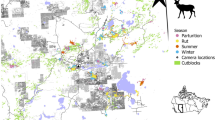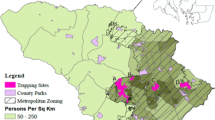Abstract
Understanding how organisms respond to landscape heterogeneity is foundational to landscape ecology. We characterized seasonal scales of movement of white-tailed deer (Odocoileus viginianus) in an agricultural–forest matrix using first-passage time analysis (FPT) for 62 GPS-collared individuals. We investigated whether those scales were driven by demographic or landscape features. We found FPT for each individual across all seasons was typically dominated by a peak in variance of FPT/area at scales (radii) from 425 to 1,675 m. These peaks occurred at scales consistent with seasonal space use. We observed additional lower magnitude peaks at larger scales (3,000–6,000 m) and small scales (25–150 m). Peaks at larger scales were associated with seasonal migrations and dispersal events. Small scale peaks may represent resting or foraging behavior. Female movements were organized at smaller scales than males in the spring/summer season. Models relating landscape features to movement scales suggest that deer perceive and move within the landscape differently as the roles of dominant land-cover types shift seasonally. During winter, configuration (interspersion/juxtaposition) of land-cover types is more important to deer than during spring/summer and fall. During spring/summer and fall, movement behavior may be dictated by reproductive and harvest activities.






Similar content being viewed by others
References
Alverson WS, Waller DM, Solheim SL (1988) Forests too deer: edge effects in northern Wisconsin. Conserv Biol 2(4):348–358
Anderson J, Hardy E, Roach J, Whimer R (1976) A land use and land cover classification system for use with remote sensor data. United States Government Printing Office, Washington
Bell WJ (1991) Searching behavior: the behavioral ecology of finding resources. Chapman and Hall, Cambridge
Bertrand MR, DeNicola AJ, Beissinger SR, Swihart RK (1996) Effects of parturition on home ranges and social affiliations of female white-tailed deer. J Wildl Manag 60(4):899–909
Calenge C (2006) The package adehabitat for the R software: a tool for the analysis of space and habitat use by animals. Ecol Model 197(3–4):516–519
Conner MM, Ebinger MR, Blanchong JA, Cross PC (2008) Infectious disease in cervids of North America. Ann N Y Acad Sci 1134:146–172 (The Year in Ecology and Conservation Biology 2008)
Cushman SA, McKelvey KS, Hayden J, Schwartz MK (2006) Gene flow in complex landscapes: testing multiple hypotheses with causal modeling. Am Nat 168(4):486–499
Dechen Quinn A (2010) Influences of movement behavior and space use in evaluating disease risk among white-tailed deer in central New York. PhD dissertation, State University of New York College of Environmental Science and Forestry
Fauchald P (1999) Foraging in a hierarchical patch system. Am Nat 153(6):603–613
Fauchald P, Tveraa T (2003) Using first-passage time in the analysis of area-restricted search and habitat selection. Ecology 84(2):282–288
Fauchald P, Tveraa T (2006) Hierarchical patch dynamics and animal movement pattern. Oecologia 149(3):383–395
Fortin MJ, Dale M (2005) Spatial analysis: a guide for ecologists. Cambridge University Press, Cambridge
Fortin MJ, Keitt TH, Maurer BA, Taper ML, Kaufman DM, Blackburn TM (2005) Species’ geographic ranges and distributional limits: pattern analysis and statistical issues. Oikos 108(1):7–17
Frair JL, Merrill EH, Visscher DR, Fortin D, Beyer HL, Morales JM (2005) Scales of movement by elk (Cervus elaphus) in response to heterogeneity in forage resources and predation risk. Landscape Ecol 20(3):273–287
Gautestad AO, Mysterud I (2005) Intrinsic scaling complexity in animal dispersion and abundance. Am Nat 165(1):44–55
Hölzenbein S, Marchinton RL (1992) Emigration and mortality in orphaned male white-tailed deer. J Wildl Manag 56(1):147–153
Homer C, Huang C, Yang L, Wylie B, Coan M (2004) Development of a 2001 national landcover database for the United States. Photogramm Eng Remote Sensing 70:829–840
Hurst JE, Porter WF (2008) Evaluation of shifts in white-tailed deer winter yards in the Adirondack region of New York. J Wildl Manag 72(2):367–375
Kilgo JC, Labisky RF, Fritzen DE (1998) Influences of hunting on the behavior of white-tailed deer: implications for conservation of the Florida panther. Conserv Biol 12(6):1359–1364
Kilpatrick HJ, Lima KK (1999) Effects of archery hunting on movement and activity of female white-tailed deer in an urban landscape. Wildl Soc Bull 27(2):433–440
Loehle C (1995) Social barriers to pathogen transmission in wild animal populations. Ecology 76(2):326–335
Long ES, Diefenbach DR, Rosenberry CS, Wallingford BD (2008) Multiple proximate and ultimate causes of natal dispersal in white-tailed deer. Behav Ecol 19(6):1235–1242
McGarigal K, Cushman SA, Neel MC, Ene E (2002) FRAGSTATS: spatial pattern analysis program for categorical maps. Computer software program produced by the authors at the University of Massachusetts, Amherst. www.umass.edu/landeco/research/fragstats/fragstats.html
McIntyre NE, Wiens JA (1999) How does habitat patch size affect animal movement? An experiment with darkling beetles. Ecology 80(7):2261–2270
McKenzie HW, Lewis MA, Merrill EH (2009) First passage time analysis of animal movement and insights into the functional response. Bull Math Biol 71(1):107–129
Morales JM, Haydon DT, Frair J, Holsinger KE, Fryxell JM (2004) Extracting more out of relocation data: building movement models as mixtures of random walks. Ecology 85(9):2436–2445
Nathan R, Getz WM, Revilla E, Holyoak M, Kadmon R, Saltz D, Smouse PE (2008) A movement ecology paradigm for unifying organismal movement research. Proc Natl Acad Sci USA 105(49):19052
National Climatic Data Center United States Monthly Surface Data. http://www.ncdc.noaa.gov/oa/ncdc.html
Nelson ME, Mech LD (1992) Dispersal in female white-tailed deer. J Mammal 73(4):891–894
New York State Office of Cyber Security and Critical Infrastructure Coordination (2009) Street_Public. http://www.nysgis.state.ny.us/gisdata/inventories/details.cfm?DSID=932. New York State Office of Cyber Security and Critical Infrastructure Coordination (CSCIC), Albany
Ozoga JJ, Verme LJ, Bienz CS (1982) Parturition behavior and territoriality in white-tailed deer: impact on neonatal mortality. J Wildl Manag 46(1):1–11
Pinaud D (2008) Quantifying search effort of moving animals at several spatial scales using first passage time analysis: effect of the structure of environment and tracking systems. J Appl Ecol 45(1):91–99
R Development Core Team (2009) R: a language and environment for statistical computing. R Foundation for Statistical Computing, Vienna
Senft R, Coughenour M, Bailey D, Rittenhouse L, Sala O, Swift D (1987) Large herbivore foraging and ecological hierarchies. Bioscience 37(11):789–799
Turchin P (1998) Quantitative analysis of movement: measuring and modeling population redistribution in animals and plants. Sinauer Associates, Sunderland
Valeix M, Loveridge AJ, Davidson Z, Madzikanda H, Fritz H, Macdonald DW (2010) How key habitat features influence large terrestrial carnivore movements: waterholes and African lions in a semi-arid savanna of north-western Zimbabwe. Landscape Ecol 25(3):337–351
Weckerly FW, Nelson JP (1990) Age and sex differences of white-tailed deer diet composition, quality, and calcium. J Wildl Manag 54(4):532–538
Wiens JA (1976) Population responses to patchy environments. Annu Rev Ecol Syst 7:81–120
Williams DM (2010) Scales of movement and contact structure among white-tailed deer in central New York. PhD dissertation, State University of New York College of Environmental Science and Forestry
Woodson DL, Reed ET, Downing RL, McGinnes BS (1980) Effect of fall orphaning on white-tailed deer fawns and yearlings. J Wildl Manag 44(1):249–252
Worden KA, Pekins PJ (1995) Seasonal change in feed intake, body composition, and metabolic rate of white-tailed deer. Can J Zool 73:452–457
Acknowledgments
We thank J. Brunner, J. Frair, J. Major, and H. B. Underwood for constructive criticism on earlier drafts of this manuscript. Funding for this project was provided by the New York State Department of Environmental Conservation with partial support from the United States Federal Aid in Wildlife Restoration Project W-173-G. Additional support was provided by the United States Geological Survey and the McIntire-Stennis Foundation at SUNY-ESF.
Author information
Authors and Affiliations
Corresponding author
Rights and permissions
About this article
Cite this article
Williams, D.M., Dechen Quinn, A.C. & Porter, W.F. Landscape effects on scales of movement by white-tailed deer in an agricultural–forest matrix. Landscape Ecol 27, 45–57 (2012). https://doi.org/10.1007/s10980-011-9664-5
Received:
Accepted:
Published:
Issue Date:
DOI: https://doi.org/10.1007/s10980-011-9664-5




